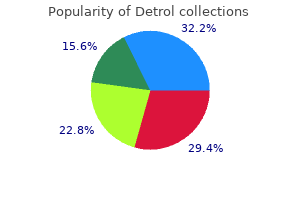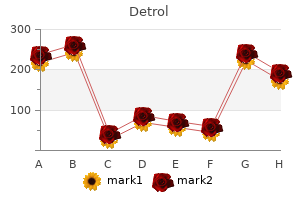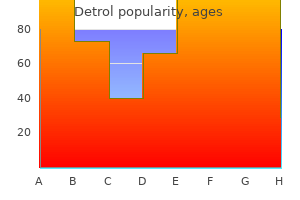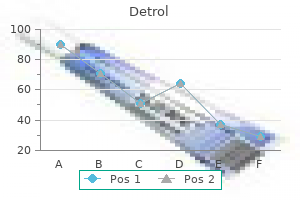Detrol

"Buy detrol 2 mg otc, medications jock itch".
A. Runak, M.A., Ph.D.
Medical Instructor, Noorda College of Osteopathic Medicine
She was unresponsive to voice 5 asa medications discount 4mg detrol visa, her eyes were open treatment notes buy discount detrol 1mg online, and she would direct her eyes to sound and would blink to threat medicine 5113 v detrol 4mg without prescription, but would not follow commands and did not respond to noxious stimuli medications like tramadol purchase 4mg detrol fast delivery. Physicians whom she recognized entered the room, but she was unable to respond to them. She reported that the noxious stimuli were very painful, but she could not move, nor could she respond to questions. She continued to think that she was dead until somewhat later in the morning, when a nurse whom she knew well sat by the bedside and talked to her gently. Because the nurse was being so nice she thought she had to respond and she began to talk. There had been no history of previous psychologic disorder nor was there any hint during the rest of her hospitalization of a psychologic abnormality. That this disorder can be tran- While the patient with the retarded form of catatonia may be difficult to distinguish from a patient with stupor caused by structural disease, the patient with the excited type of catatonia may be difficult to distinguish from a patient with an acute delirium. Both may be wildly agitated and combative, and such behavior may make it impossible to test for orientation and alertness. Hallucinatory activity can be caused by either organic or psychologic disease, although pure visual hallucinations are usually due to structural or metabolic disease, and pure auditory hallucinations to psychologic disease. The segmental neurologic examination, insofar as it can be tested in a delirious or excited patient, may be normal with either structural or organic disease. Grimacing, stereotypic motor behavior, and posturing suggest catatonia rather than metabolic delirium. Because 50% of such patients also have epilepsy, differentiating a psychogenic from an epileptic seizure in a particular episode may be very difficult. An elevated prolactin level strongly suggests that a generalized tonic-clonic or complex partial seizure is epileptic. He moved spontaneously and sometimes appeared to withdraw from noxious stimuli but never would look at the examiner or regard the examiner in any way. Gradually over the next 24 to 36 hours, the patient began to respond by closing his eyes to command, but rarely looking at the examiner. However, he had difficulty with commands involving the lips or tongue (oral buccal apraxia). However, even at discharge his affect seemed flat and he himself reported that he was not the same as prior to surgery, one can often stop the episode with intravenous benzodiazepines. However, if there is a strong suspicion that the seizures are psychogenic, anticonvulsants should not be given. Because the children were awake but mute, the disorder was called the cerebellar mutism syndrome. Whatever their level of alertness, they do not speak and often behave abnormally, either by not responding to the examiner or by behaving inappropriately. In children the syndrome characteristically occurs after a period of normality in the postoperative period. The syndrome is largely reversible, but neuropsychologic tests given long after apparent recovery demonstrate defectsinexecutive function, affect, and language. He had been operated on twice 2 years before with a vermis splitting operation that removed most of the lesion, but left residual tumor in the lateral wall of the fourth ventricle. The surgeon did not invade the vermis but lifted the cerebellar tonsil to successfully resect the residual tumor. Neurologic consultation was sought in the immediate postoperative period when the patient appeared to be ``unresponsive. The hyperintensity in the vermis is more marked and there is new hyperintensity in the right posterior lobe of the cerebellum. Comment: the cerebellar cognitive affective syndrome is rare in adults and can easily be mistaken for catatonia or psychogenic unresponsiveness. Interestingly, the surgeon noted that when she first interviewed him his affect seemed ``flat.


For men treatment solutions order 4mg detrol mastercard, lung cancer is the most common cancer in Bangladesh treatment kitty colds cheap detrol 1 mg with amex, India and Nepal symptoms graves disease cheap detrol 4mg online, while lip and oral cavity cancer is most common in Maldives treatment 8mm kidney stone purchase 4 mg detrol mastercard, Pakistan and Sri Lanka. Gastric cancer is more common among men from Afghanistan and Bhutan compared with men from the other countries of the region. Among women, breast cancer is the most common cancer in Afghanistan, Bangladesh, India, Maldives, Pakistan and Sri Lanka. Twenty per cent of the total cancer load in Nepal is due to cervical cancer, while Afghanistan has the lowest incidence of this disease in the region. The highest incidence of lip and oral cavity cancer (for both sexes) in the region has been reported for Maldives. This is followed by Sri Lanka, Pakistan, Bangladesh, India, Afghanistan and Nepal. The incidence of cancer of the oesophagus is the highest in Bangladesh, while it is lowest in Nepal. Bhutan has shown the highest rates of incidence for stomach, nasopharynx and liver cancers. In Afghanistan, the age adjusted incidence rates of cancer of the urinary bladder, kidney, colorectum and brain are highest among the various countries in South Asia. The five most common cancers seen in different countries of South Asia are shown in Table 25. Risk factors No matter how effective cancer treatment may become, prevention comes first. Exposure to tobacco and its byproducts is by far the best known and most frequent cause of cancer in adults, causing an estimated 40% of all deaths from cancer. The most common tobacco related cancers in the region are those of the lung, head and neck, and oesophagus. South Asia is the largest region in the world for the production and consumption of tobacco products. An open market and more disposable income make South Asian countries attractive markets for such products as tobacco and alcohol. Bangladesh has the highest rate of tobacco smoking, followed by Maldives, Pakistan, Nepal, India and Sri Lanka. Smoking rates are much higher for men than for women, except in Nepal where it is high for both sexes. Higher taxation of cigarettes has been found globally to be the single most effective intervention to decrease smoking. Annual per capita consumption of alcohol has increased in countries like India and Nepal [25. Other factors include the increase in the population of this region, especially the increase in the ageing population (when the incidence of many cancers becomes most noticeable). National cancer control programmes and cancer registries While some countries such as Bangladesh, India, Pakistan and Sri Lanka have national cancer control programmes, other countries of the region lack an organized cancer control strategy [25. Population based cancer registries, albeit with limited coverage, are operational in India, Pakistan and Sri Lanka [25. Radiotherapy Radiotherapy plays a fundamental role in the continuum of cancer care and its key role in the management of cancer is likely to continue for several years to come. The recognition of the need for radiotherapy is higher in this region, 417 as shown by the advanced stage of presentation and different profiles of cancer cases. However, it is necessary to improve and expand radiotherapy services, ideally within the framework of national cancer control strategies. It is possible to provide effective radiotherapy services for most cancer cases at a moderate cost, even without recourse to sophisticated technology. External beam radiotherapy can be accurately and safely delivered with cobalt-60 units or medical linacs. For example, the lack of timely accessibility of radiotherapy prevents the achievement of optimal results. Geographical or spatial accessibility and the ability patients and their family members to cover the direct and the indirect costs of treatment are major barriers preventing access to radiotherapy services. The majority of radiotherapy centres are concentrated in major cities, leaving large geographical gaps.

The Achilles tendon symptoms gallbladder order detrol 1mg fast delivery, an extension of the gastrocnemius and soleus muscles treatment yellow jacket sting generic detrol 4 mg without a prescription, attaches to the calcaneus adjacent to the apophysis symptoms 5 weeks pregnant cramps cheap 1 mg detrol amex. With contraction of the calf muscles administering medications 7th edition answers buy detrol 2mg, the Achilles tendon puts tension on the apophysis, causing mechanical irritation. Direct force applied by high impact activities such as running and jumping also irritate the apophysis. Use of a soft heel cup in the shoe can blunt the force applied to the apophysis and appears to relieve symptoms. Activity modification or restriction is indicated for patients with significant pain or alteration in gait despite the use of symptomatic treatment. The symptoms of Sever disease typically abate when the apophysis closes, within 1 to 2 years of onset. Radiography may be useful to rule out other conditions and may show fragmentation or sclerosis of the calcaneal epiphysis. Magnetic resonance imaging may be indicated if stress fracture or osteomyelitis of the calcaneus is suspected. Elevation of the erythrocyte sedimentation rate may be seen with infection or an inflammatory condition such as juvenile idiopathic arthritis. The liver and spleen are palpable 2 cm and 1 cm below the right and left costal margins, respectively. However, if this testing does not occur, an infant can present with symptomatic infection in the weeks after birth. Intrauterine infection with T pallidum can result in stillbirth, preterm birth, hydrops fetalis, or asymptomatic infection. Infants such as the child described in the vignette, can have: o hepatosplenomegaly o copious nasal secretions (snuffles) o cutaneous lesions o edema o lymphadenopathy o osteochondritis o pneumonia o pseudoparalysis o hemolytic anemia o thrombocytopenia An untreated intrauterine infection can affect the: o central nervous system (eighth cranial nerve deafness) o eyes (interstitial keratitis) o teeth (peg-shaped incisors [Hutchinson teeth], mulberry molars) o bones (frontal bossing, saddle nose, tibial bowing) o joints (swelling of knees [Clutton joints]) o skin (ulceration, desquamation, palpable lesions) Acquired syphilis occurs in 3 stages: primary, secondary, and tertiary. The primary stage of infection is characterized by 1 or more painless ulcers (chancres) on the skin or mucous membranes at the initial site of inoculation that develop approximately 3 weeks after exposure. The secondary stage of syphilis is characterized by lymphadenopathy, mucocutaneous lesions, and rash. Patients may experience flulike symptoms such as fever, headache, sore throat, arthralgias, and malaise. The period following the secondary stage is called the latent period during which time patients are asymptomatic and seroreactive but may suffer recurrences of secondary stage symptoms. The tertiary stage of syphilis occurs 15 to 30 years after initial infection and can include neurosyphilis, cardiovascular symptoms, and gumma formation. For patients with penicillin allergy and neurosyphilis, congenital syphilis, syphilis during pregnancy, or human immunodeficiency virus infection, desensitization is recommended. The recommended evaluation and treatment of neonates exposed to mothers infected with T pallidum is outlined in Item C75A. The recommended treatment for syphilis in patients older than 1 month of age is displayed in Item C75B. Cutaneous infection caused by Candida typically is described as an erythematous rash with satellite lesions; it typically would not be isolated to the feet as described for the patient in the vignette. Similarly, acquired cytomegalovirus infection could present with a diffuse, nonspecific rash but not with localized findings. The classic "blueberry muffin" rash of congenital cytomegalovirus infection (Item C75E) would be present at or shortly after birth and not develop in the third week after birth as described for the patient in the vignette. Lastly, late-onset infection caused by group B Streptococcus (S agalactiae) may present as cellulitis but discrete copper-colored macular lesions are not characteristic findings. Her mother is concerned that her daughter has an ear infection because she has been crying frequently. Physical examination is remarkable only for clear rhinorrhea from both nares and a swollen, tender right wrist with bruising over the dorsal aspect. When you inquire about any history of trauma, the mother explains that the girl is extremely active and "very accident prone," but that she recalls no specific injury.

Syndromes
- Skin conditions such as lichen planus, lichen sclerosis, seborrheic dermatitis, and vitiligo
- Vomiting - possibly blood
- Chills
- Infants in a nursery where an outbreak has occurred
- Breast milk - pumping and storage
- CBC with differential
Symptoms Headache Vomiting Drowsiness Unsteadiness Confusion Ipsilateral limb weakness Visual disturbances Blackout Signs Nystagmus Meningismus Cerebellar signs Papilledema Fever Sixth nerve palsy Depressed consciousness *Data from Shaw and Russell medicine 751 discount 2 mg detrol amex. The contrast-enhanced image will not only identify the enhancing cerebellar tumor medications with pseudoephedrine order detrol 2 mg visa, but will also inform the physician whether there are other metastatic lesions and whether hydrocephalus is present symptoms to diagnosis detrol 1 mg on-line. The treatment of a single metastasis in the cerebellum is generally surgical or medicine dispenser purchase detrol 2 mg line, in some instances, by radiosurgery. On examination, there was right lateral gaze paresis and inability to adduct either eye on lateral gaze (one-and-a-half syndrome). He was treated with anticoagulants and improved slowly, although with significant residual diplopia and left hemiparesis at discharge. Most patients have impairment of oculocephalic responses, and eyes may show skew deviation, ocular bobbing, or one of its variants. Patients may have decerebrate rigidity, or they may demonstrate flaccid quadriplegia. However, in most patients, the onset of coma is so sudden that there is not even a history of a complaint of headache. To cause coma, a supratentorial lesion must either involve bilateral cortical or subcortical structures multifocally or diffusely or affect the thalamus bilaterally. This appearance is also seen in patients during a Wada test, when a barbiturate is injected into one carotid artery to determine the lateralization of language function prior to surgery. The appearance of the patient may be deceptive to the uninitiated examiner; acute loss of language with a dominant hemisphere lesion may make the patient unresponsive to verbal command, and acute lesions of the nondominant hemisphere often cause an ``eyeopening apraxia,' in which the patient keeps his or her eyes closed, even though awake. However, a careful neurologic examination demonstrates that despite the appearance of reduced responsiveness, true coma rarely occurs in such cases. In the absence of such a situation, unilateral carotid occlusion does not cause acute loss of consciousness. Patients with large hemispheric infarcts are nearly always hemiplegic at onset, and if in the dominant hemisphere, aphasic as well. Symptoms may be relieved by early use of thrombolytic agents,186 but only if the stroke is identified and treated within a few hours of onset. There are currently no neuroprotective agents that have demonstrated effectiveness. Patients with massive infarcts should be given good supportive care to ensure adequate blood flow, oxygen, and nutrients to the brain, but hyperglycemia should be avoided as it worsens the outcome. Although impairment of consciousness is rare as an immediate result of carotid occlusion, it may occur 2 to 4 days after acute infarction in the carotid territory, as edema of the infarcted hemisphere causes compression of the other hemisphere and the diencephalon, and may even result in uncal or central herniation. It may be diminished transiently with mannitol or hypertonic saline,191 but these agents soon equilibrate across the blood-brain barrier and cease to draw fluid out of the brain, if they ever did192,193 (see Chapter 7). Surgical resection of the infarcted tissue may improve survival,194,195 but this approach often results in a severely impaired outcome. Decompressive craniotomy (removing bone overlying the damaged hemisphere) may increase survival, but many of the patients have a poor neurologic outcome. Development of cerebral edema and herniation in a patient with a left middle cerebral artery infarct. A 90-year-old woman with hypertension and diabetes had sudden onset of global aphasia, right hemiparesis, and left gaze preference. By 48 hours after admission, there was massive left cerebral edema, with the medial temporal lobe herniation compressing the brainstem (arrow E) and subfalcine herniation of the left cingulate gyrus (arrow in F) and massive midline shift and compression of the left lateral ventricle. The posterior cerebral arteries also give rise to posterior choroidal arteries, which perfuse the caudal part of the hippocampal formation, the globus pallidus, and the lateral geniculate nucleus. On the other hand, more proximal occlusion of the basilar artery that reduces perfusion of the junction of the midbrain with the posterior thalamus and hypothalamus bilaterally can cause profound coma.
